100 years of performance
1900s-1940s 1939-1945 1960s-1980s 1970s-early 1980s 1990s-2000s 2015-today
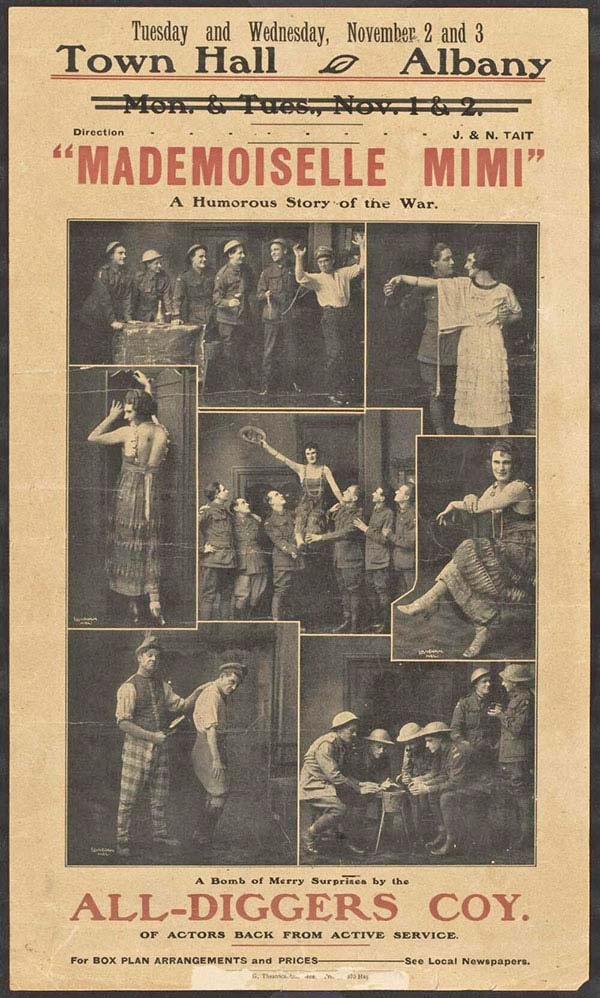 Mademoiselle Mimi: a humorous story of the war, 1920. Courtesy of the National Library of Australia.
Mademoiselle Mimi: a humorous story of the war, 1920. Courtesy of the National Library of Australia.Combining the art of impersonation and drag with their comedic chops and musicality, these Queer stars of the stage and screen have entertained Tweed audiences for almost a century.
1900s-1940s
Vaudeville & post WW1 variety shows
After World War I, vaudeville troupes frequently toured Northern New South Wales, offering an assortment of speciality acts that included song and dance, comedy and impersonation.
Norman Croft's Gallipoli Strollers, who visited Tweed in 1922, featured female impersonator, Hector Gray. Hector caught the eye of a Tweed Daily reporter who wrote that Hector had proved to be the "perfect lady", his "gestures and mannerisms were a clever imitation of the other sex".
Earlier in 1921, the show Musical Comedy featured Mademoiselle Mimi, a most charming "damsel" performed by Mr Lindsay Kemble. Mimi impressed a crowded house at the Murwillumbah School of Arts with the art of their illusion; “he is the bewitching little French girl, even to the dimples in the cheeks", reported the Daily News. The paper also claimed that Lindsay was "a remarkably clever female impersonator in speech, song and action".
Lindsay Kemble achieved national notoriety after being arrested in 1915 dressed as a woman, which served as inspiration for a short comedy film that turned him into an overnight vaudeville star.
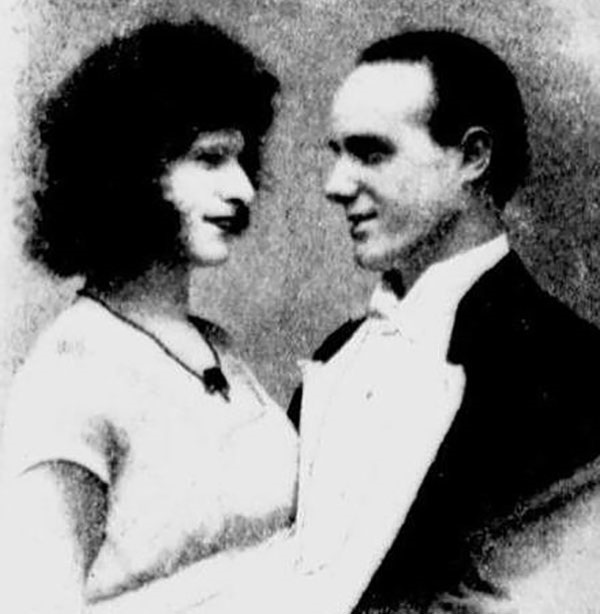 Private Victor Kemble and Driver Roy Glenister of the Sentimental Blokes, 1918. Sydney Mail.
Private Victor Kemble and Driver Roy Glenister of the Sentimental Blokes, 1918. Sydney Mail.Later, in 1935, Mack's Musical Comedy Company played at Dobson's Garage in Coolangatta, returning in 1940 to play in an open marquee theatre at Knox Park. The company included Miss Nellie Kolle, said to be the "greatest Australian male impersonator" (Tweed Daily) and the "the possessor of a splendid stage voice" (The Border Star).
In 1940 the Tweed Daily reported that Nellie had proved a popular favourite, having received several encores. Despite being married with two children, Nellie refused to give up the stage for domestic life, maintaining her presence on the variety stage in Australia for almost twenty years (Australian Variety Theatre Archive, 2012). Nellie's gift for mimicry and vocal ability saw national newspapers declaring her to be Australia's own sweetheart.
Many other performers travelled to the Tweed. Female impersonator Colin Croft performed in Murwillumbah in 1937 to a sold out crowd.
The huge popularity of Vaudeville and the variety shows that toured Australasia during this era presented an ‘acceptable’ platform for many of these talented artists to express their authentic selves, temporarily safe from the persecution some faced outside the theatres and concert halls.
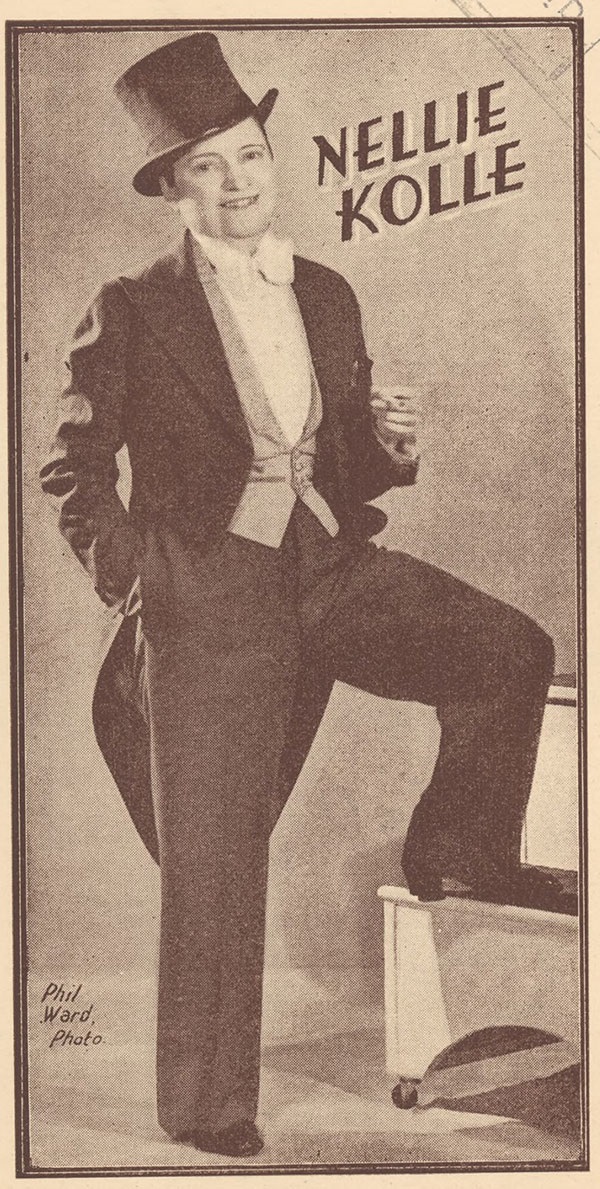 Nellie Kolle on the cover of ‘One for the Road’, 1939. Courtesy of the National Library of Australia.
Nellie Kolle on the cover of ‘One for the Road’, 1939. Courtesy of the National Library of Australia.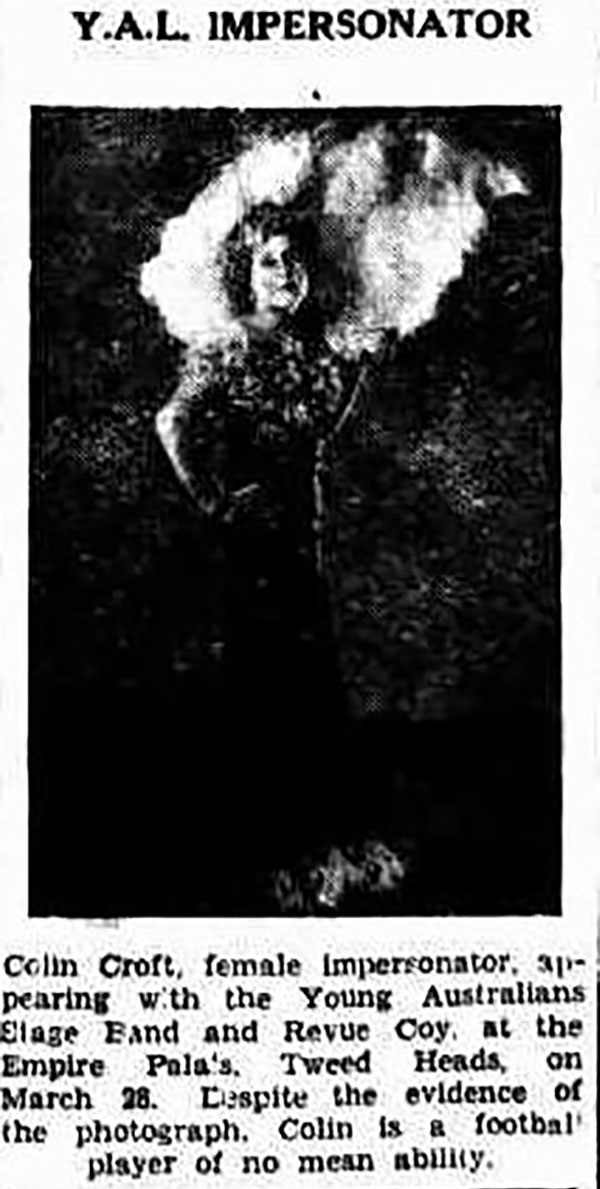 Colin Croft, Female Impersonator, 1938. Border Star.
Colin Croft, Female Impersonator, 1938. Border Star.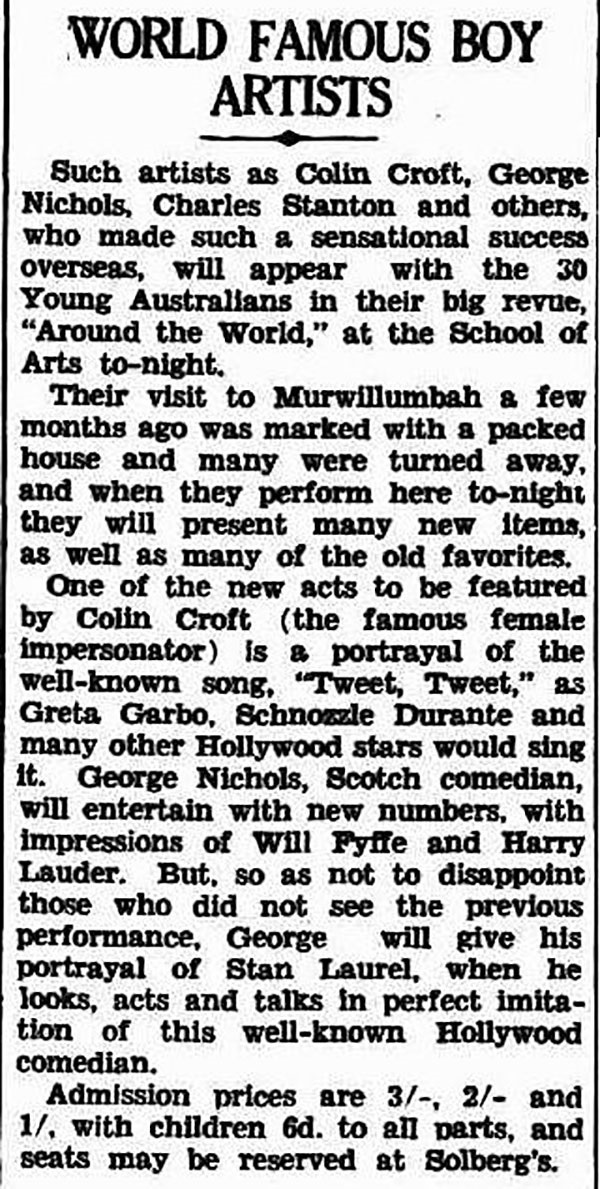 World Famous Boy Artists, 1937. Tweed Daily.
World Famous Boy Artists, 1937. Tweed Daily.
1939-1945
WWII armed forces theatre
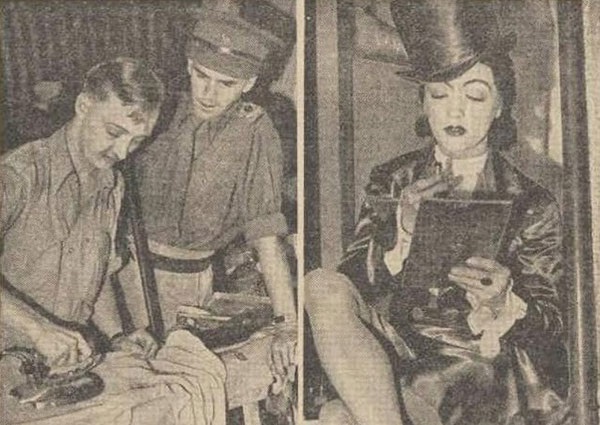 Corporal Ian Maehle, 1943. Australian Women's Weekly.
Corporal Ian Maehle, 1943. Australian Women's Weekly.  Waratahs Mobile Theatre, 1943. Australian Women's Weekly.
Waratahs Mobile Theatre, 1943. Australian Women's Weekly.Organised entertainment of armed forces during WWII served to boost morale and relieve the monotony of war weary soldiers.
Field theatre productions were often a combination of music hall, vaudeville and costume comedy, and included songs, comedy routines, sketches, magic, and scenes from well-known plays and films. Female impersonation was a specific feature of these productions, and most entertainment troupes had at least one performer who specialised in this role.
One such entertainment group was the Waratahs Mobile Army Theatre Troupe. The Troupe was formed in 1942 and played at all the main army camps, hospitals and theatres of New South Wales. In 1943, the Waratahs All-Digger Revue visited Murwillumbah, possibly in Knox Park. The self-contained theatre, purpose-built by the Army, folded from a canvas trailer to form the eighteen-foot square stage, seen in the image below.
The travelling convoy comprised of six trucks and a 21 member crew, all of whom were professional musicians and entertainers already serving in the Army. They all carried full fighting kit as they could be called up at any moment. The wardrobe master, Corporal Ian Maehle, was also an actor and singer. Watch Corporal Ian Maehle performing in costume the song 'Olga Polovski, the beautiful spy’:
1960s-1980s
Coolangatta Hotel and the Moselle Brothers
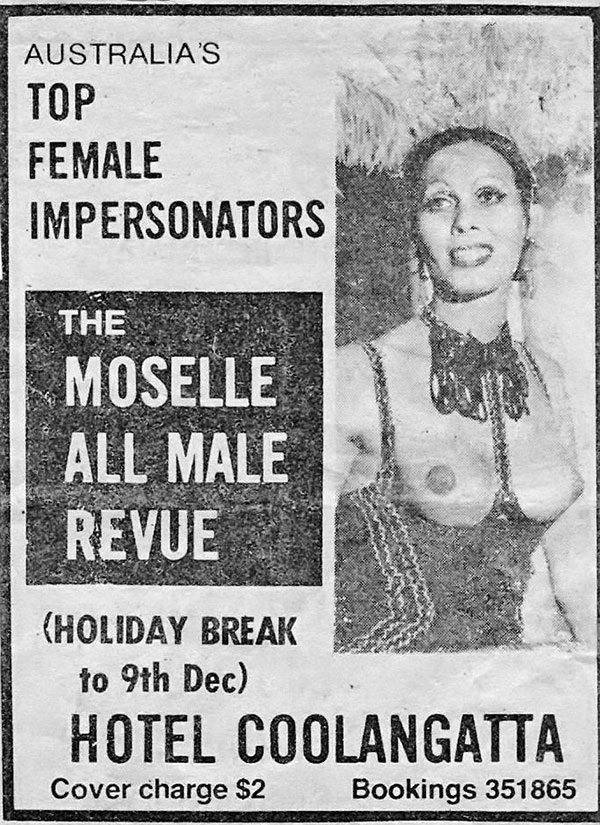 The Moselle All Male Revue featuring Rita Marina, 1974. Daily Mirror.
The Moselle All Male Revue featuring Rita Marina, 1974. Daily Mirror.The Moselle Brothers (Peter and Johnny) were variety performers and female impersonators who entertained in Coolangatta and the Tweed in the 1960s-1980s.
First meeting in London in 1946, they later joined forces in Australia and began producing, choreographing, compering and performing in all-male revues and variety shows. ‘The Moselle Brothers’ was a stage name; Peter and Johnny were not related to each other.
In the mid-1960s, the duo moved to the Gold Coast, where they opened The Peter Moselle Show at the Coolangatta Hotel attracting sell-out crowds for almost every show.
Their shows featured many local performers including the world-famous Holly Brown. Holly was a talented impressionist, singer and dancer, compere, comedienne and artist. As a 15-year-old country kid, she moved to Sydney to model and worked in female impersonation. She relocated to the Gold Coast in the late 1960s to perform in The Peter Moselle Show and was known for her beauty, stage work and costume design. Throughout her career, Holly "broke new ground and was always Avante Garde and exotic in her approach to stagecraft" (Star Observer, 1991).
In 2009, Regina King, a close friend and fellow performer, told the Gold Coast Bulletin of her time performing in the Peter Moselle Show at the Coolangatta Hotel, "It was packed to the rafters every night we performed," she said. "Everyone used to talk about the show and not just because the male performers were actually dressing as women, but because it was just an incredibly fun show."
Johnny Moselle was Mary to his mates and, according to Regina, Johnny told a great yarn. "He would sit in the interval, sipping a coldie and tell so many stories about performing all over the world”. In an interview in The Sunday Mail, Johnny reflected on the perils of shopping for his profession, "It's sometimes quite embarrassing to sit among the ladies trying to fit my feet into a pair of sleek stiletto heels. You should see the way the other customers look at my hairy legs…Choosing bouffant wigs or dress material isn't nearly as harrowing."
The duo went their separate ways in 1973, Peter continuing his Moselle revues at the Top of the Town in Brisbane and Johnny remaining at the Coolangatta Hotel as The Johnny Moselle Show. They eventually reformed to play shows at Seagulls Leagues Club and the Coolangatta Hotel, where they stayed for another five years.
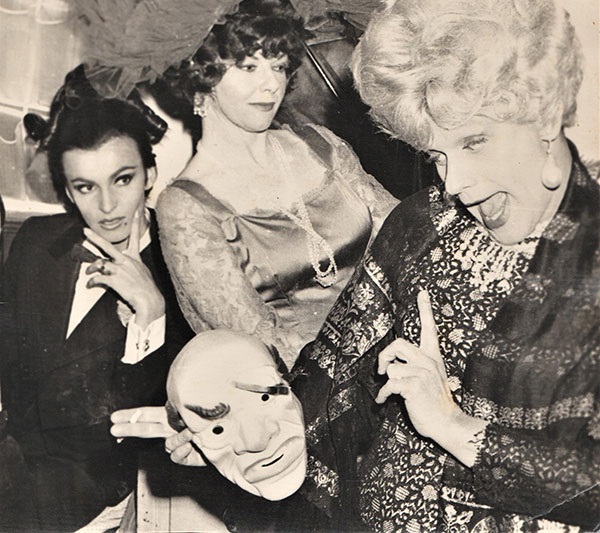 Holly Brown, Regina King and Peter Moselle, Coolangatta Hotel. Courtesy of Regina King.
Holly Brown, Regina King and Peter Moselle, Coolangatta Hotel. Courtesy of Regina King.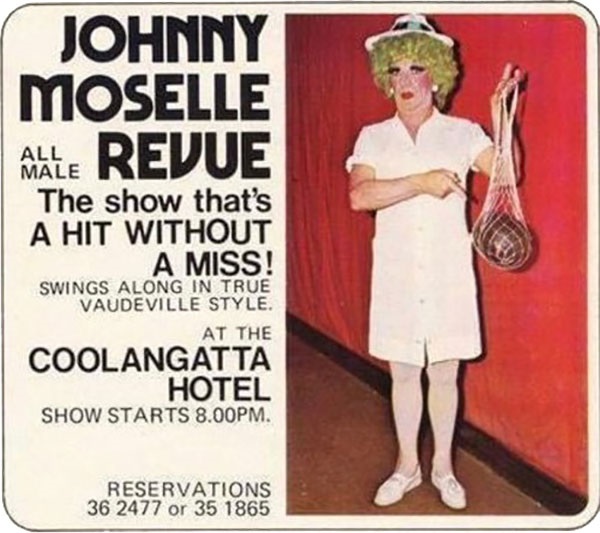 Johnny Moselle, Focus Tower Advertisement from 'This Week on the Gold Coast', 12-18 Oct 1976.
Johnny Moselle, Focus Tower Advertisement from 'This Week on the Gold Coast', 12-18 Oct 1976.
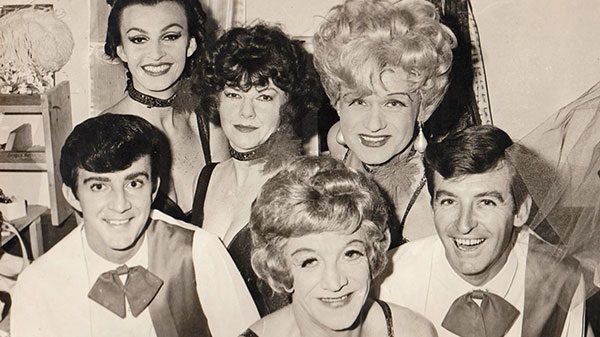 The Peter Moselle Show, left to right: Tommy Rinaldo, Holly Brown, Regina King, Johnny Moselle, Peter Moselle, Billy Rinaldo, Coolangatta Hotel. Courtesy of Regina King.
The Peter Moselle Show, left to right: Tommy Rinaldo, Holly Brown, Regina King, Johnny Moselle, Peter Moselle, Billy Rinaldo, Coolangatta Hotel. Courtesy of Regina King.
Watch a video interview of The Moselle Brothers discussing their career on Tamara Tonight.
1970s-early 1980s
Leisure club camp
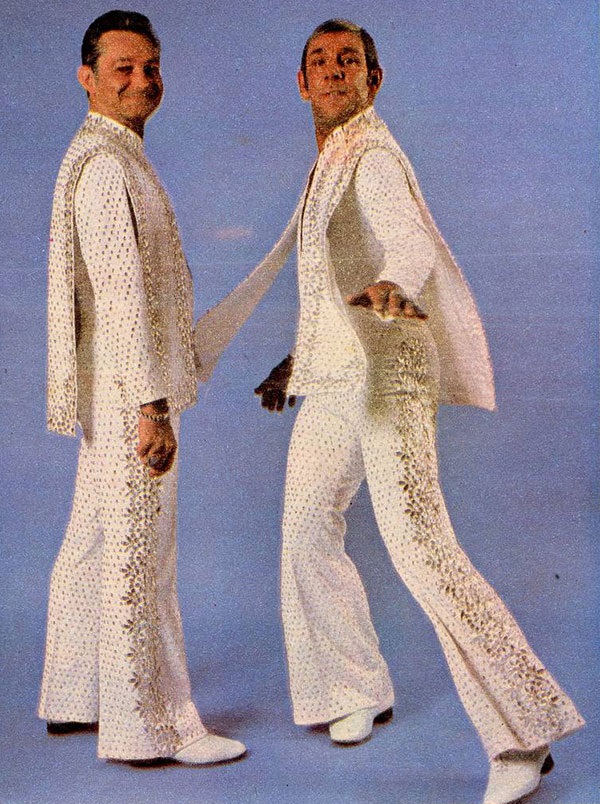 Kevin and Erris in People Magazine, 1976. Photographer: Wal Easton.
Kevin and Erris in People Magazine, 1976. Photographer: Wal Easton.During the 1970s and 1980s, the Tweed’s leisure clubs regularly hosted many world-famous camp and queer performers to sold-out audiences. Tweed residents and visitors from across the Queensland border flocked to clubs like Twin Towns to see international star acts like The Village People and Peter Allen.
Dazzling audiences on another club stage down the road, with their flamboyant costumes and glittering style, were song-and-dance men, Erris Venske and Kevin Byers, who regularly played at the Tweed Heads Bowls Club throughout the 1960s and 70s.
Kevin and Erris met on the Gold Coast in the late 1950s. Sharing a love of performance, they decided to partner in 1959 and became the ‘The Peacock Pair’. They describe their fast-moving act as a “bit of high camp”, combining old-time vaudeville and modern revue. When asked by a reporter if they ever aroused hostility from the club audiences, Kevin replied, “Not really…most audiences enjoy the entertainment. And we build the act on the reaction of the audience anyway.”
Their Liberace-esque wardrobe was designed and made by Kevin, who learned tailoring from his mother. They were intended to catch the audience’s attention and reflected their showbiz personalities. As Erris explained to the Gold Coast Bulletin in 1976, “Our act isn’t an act really…it is how we are all the time. We are ourselves, on and off stage, and our costumes are just another avenue of expression”.
Popular Aussie acts like Wickety Wak and Glenn Shorrock were also a mainstay on the club circuit, returning year after year to packed auditoriums. These ‘cross-dressing’ men adopted the iconic costumes of divas like Tina Turner and the much-lampooned back-up dancers from Robert Palmer’s Simply Irresistible video clip. More comedy skit than impersonation, these tongue-in-cheek performances were met with enthusiastic appreciation.
1990s-2000s
From stage to screen and airways
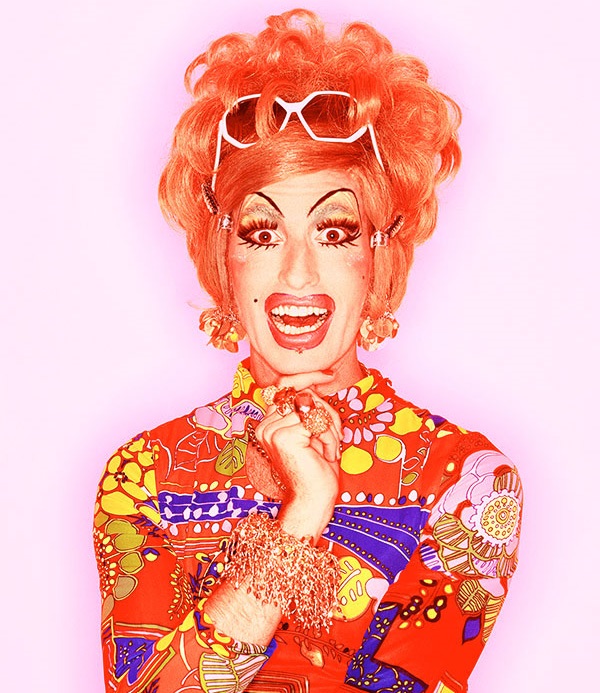 Vanessa Wagner. Courtesy of Tobin Saunders.
Vanessa Wagner. Courtesy of Tobin Saunders.After the painful aftermath of the HIV-AIDS panic of the 1980s and the early 1990s, a new era in drag began when performers ventured beyond the bars and clubs to find a new audience, in part thanks to a little Australian film called The Adventures of Priscilla, Queen of the Desert.
Priscilla became a worldwide smash hit in 1994 and introduced the art form to a broader, more mainstream audience. Emerging from this pivotal time in drag history was Vanessa Wagner, the fabulous alter ego of Northern Rivers’ local Tobin Saunders. According to Tobin, Vanessa started as a dedicated housewife and part-time hostess and went on to become one of Australia’s most colourful and entertaining identities.
From the success of ‘Jamie & Vanessa’ events in Sydney, Vanessa was invited by Judith Lucy to appear on Triple J’s Ladies Lounge program as an ‘etiquette coach’. This national attention propelled Tobin’s career. As Vanessa, he become the street reporter for early televised coverage of the Sydney Gay and Lesbian Mardi Gras. In 2000 Vanessa was invited to feature in the Priscilla, Queen of the Desert float at the closing ceremony parade at the Sydney Olympic Games. Shortly after that, Tobin/Vanessa participated in Australia’s first celebrity Big Brother TV Show on the Gold Coast. Read more about Tobin Saunders.
2015-today
Contemporary and future direction of queer performance
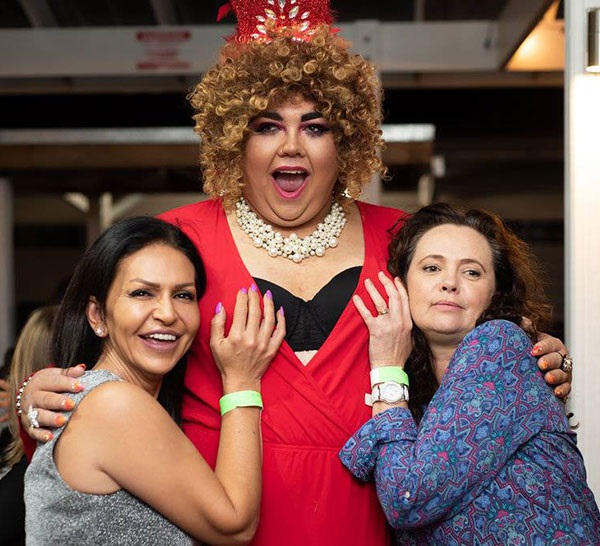 Milena Missi and audience members, 2019. Courtesy of Mitchell Hull.
Milena Missi and audience members, 2019. Courtesy of Mitchell Hull.After a long hiatus, drag has made its long awaited comeback to the Tweed thanks to local drag artist, Mitchell Hull. After expressing an interest in performing to the manager of a Surfers Paradise nightclub, Milena Missi was born. In 2015 she took to the stage, lip-syncing for the first time to Valerie by Amy Winehouse. Taking inspiration from Australian drag queen, Art Simone, and the northern Gold Coast drag scene, Mitchell is mostly self-taught. Having learnt the art of drag from watching Rupaul’s Drag Race and YouTube, he describes Milena Missi as a plus-size comedy Queen.
After a year of performing in Surfers Paradise, Mitchell returned to the Tweed to care for a family member. Read more about Mitchell’s story. By 2018 Mitchell was ready to return to performing. Wanting to remain on the Tweed Coast, he created Queens From Kingscliff. Almost immediately, Mitchell had booked gigs at Phoebe's Mediterranean House in Kingscliff and Pavilions Hotel in Terranora. The success of the business evolved into other events including Balls out Bingo, weddings and New Year’s Eve parties. Milena Missi even made the cover of the local rag – in drag!
Having lost most of his gigs when the Covid19 pandemic first hit in 2020, Mitchell quickly responded by adapting the show. He put a call out over social media, proposing to bring Queens From Kingscliff to people’s front doors in an innovative new Driveway Drag show. Queens From Kingscliff has been busier than ever.
While keeping a safe distance from the audience, Milena Missi and the Queens From Kingscliff continue to entertain locals with their driveway performances. As Mitchell recently told the Tweed Daily News, "we just want to make you laugh, giggle or dance around for half an hour".
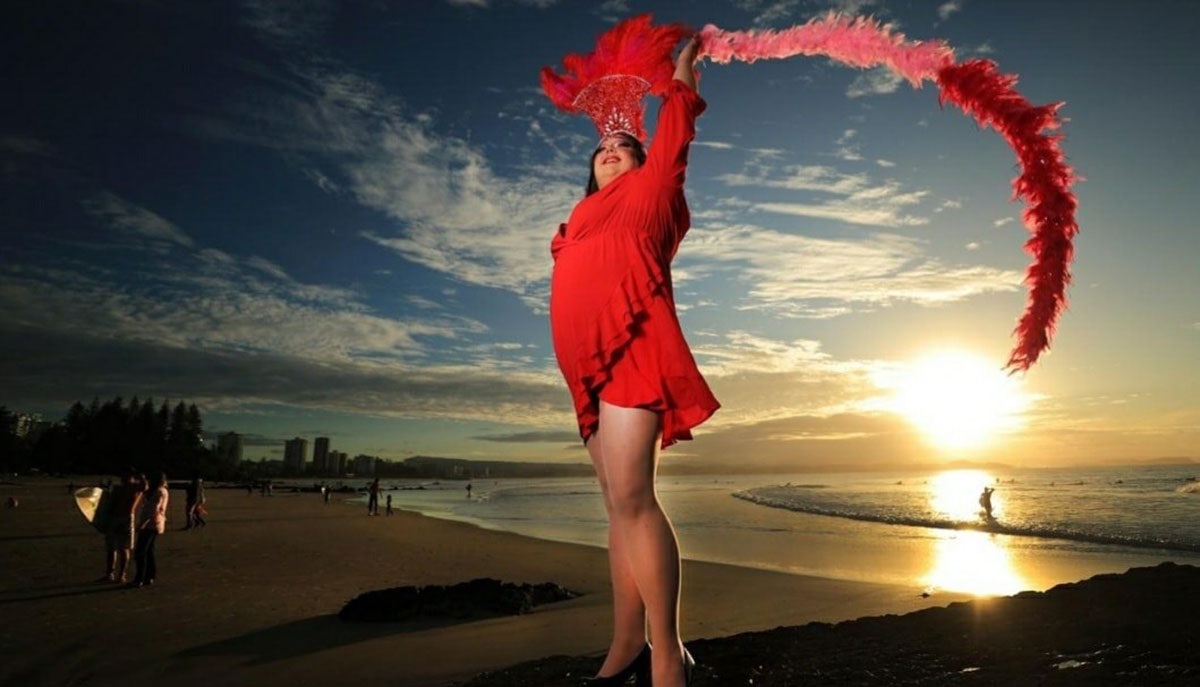
Milena Missi, Tweed Daily News, 2020. Photographer: Scott Powick.